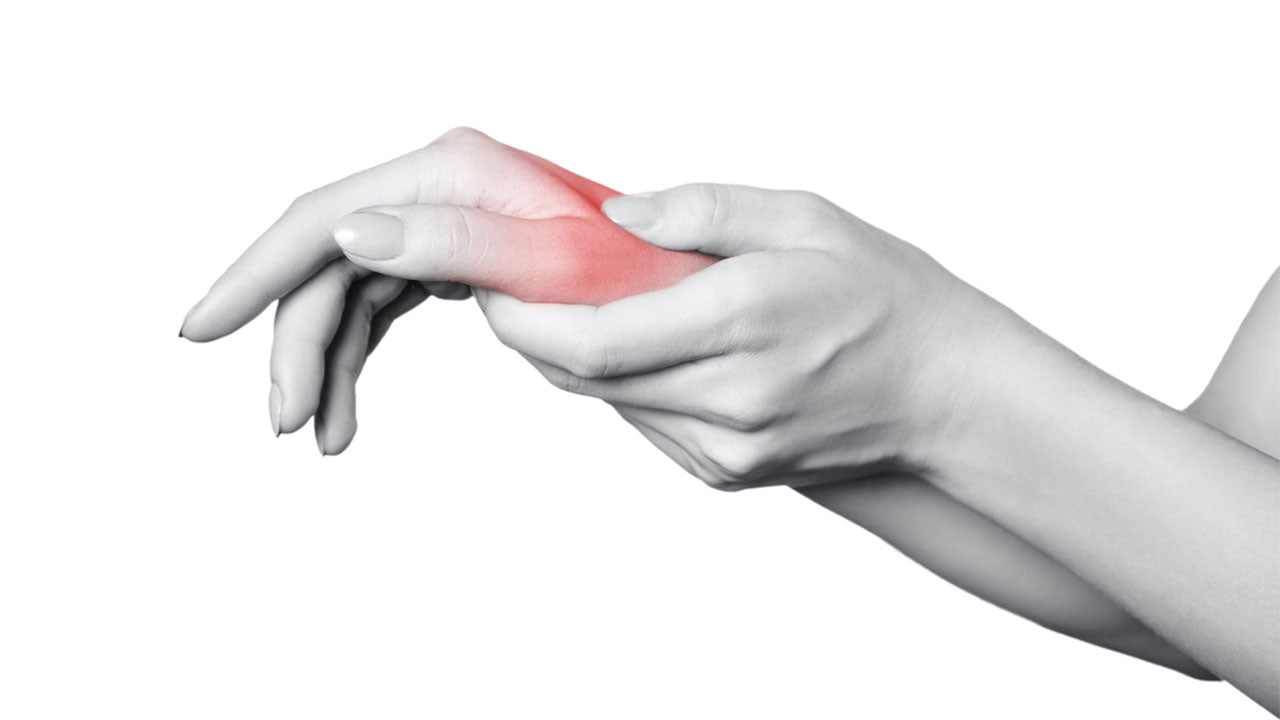Thumb Knuckle Pain: The Top 6 Possible Causes
 By: by Amino Science
By: by Amino Science

If you have persistent pain at the base of the thumb, right at the knuckle joint, or in your thumb pad, you might be worried about what it could mean. Did you sprain your thumb, somehow sleep on it wrong, or could it be a sign of rheumatoid arthritis? This article reviews a few thumb knuckle pain culprits, and what you can do to help treat the cause of this discomfort.
Joint Pain Overview
If you're young and experiencing joint pain, you may not immediately jump to the conclusion that it could be arthritis or some other serious joint-affecting condition like degenerative joint disease or gout. However, data shows that these conditions, though statistically more likely to develop with age, can afflict people as young as 40 (arthritis) or 30 (gout). In all honesty, our bodies start declining in little ways after the age of 25, and after that it's just the luck of the draw on the genetic lottery sometimes, especially with autoimmune conditions like rheumatoid arthritis.
If you're experiencing unexplained tenderness anywhere from the base of the thumb to thumb middle joint pain, discomfort so palpable that it's interfering with your thumb's range of motion, then it could be the sign of a serious condition, regardless of your age.

Thumb Knuckle Pain: The Top 6 Possible Causes
Our thumb joints are one of the evolutionary wonders that differentiate us from our ape ancestors, and thumb knuckle pain can throttle your fine motor skills.
If you can't think of any reason why your thumb knuckle is in pain—something as innocent as maybe you spent some time cracking walnuts or you've gotten a new keyboard and it could be a mild case of wrist tendinitis—then you could be worrying about one of the following underlying conditions.
1. Basal Joint Arthritis or Osteoarthritis
Basal joint arthritis could be causing your joint pain. The basal joint lies at the base of your thumb, just above the wrist. A wearing away of the cartilage in this joint is commonly called "thumb arthritis," and comes not only with pain but also the loss of thumb mobility and the possible loss of thumb grip strength.
Our joint cartilage provides a cushion at the spot where two bones would otherwise meet and grind together. Cartilage cannot heal on its own, because, unlike other forms of tissue in the body, it has no blood supply to provide a healing pathway. Becoming aware of cartilage damage as soon as possible is important so you can ask your doctor how to prevent further breakdown.
Cartilage breakdown in the joints is also known as osteoarthritis, and it's the most common form of arthritis worldwide.
2. Rheumatoid Arthritis
Thumb arthritis could also be caused by rheumatoid arthritis in the thumb. Rheumatoid arthritis is a chronic inflammatory autoimmune disorder that can affect many of your joints. Rheumatoid pain in your thumb joint might be experienced as a stabbing, burning, or milder creaking pain.
3. Carpal Tunnel Syndrome
Carpal tunnel syndrome is characterized by a pinched or compressed median nerve in the "tunnel" it travels through your wrist. This could cause tingling, burning, numbness, or weakness in your finger joints, thumb joints, or wrists. A common condition in the United States, carpal tunnel affects up to 6% of adults, though it's more likely to occur in women rather than men.
Long-term repetitive movements of the hand are risk factors for developing carpal tunnel. Imagine the repetitive work of jobs like stenographer, cashier, assembly line worker, musician, or hair stylist.
4. Sprain, Injury, or Break
A sprained, jammed, or even broken thumb could cause pain in the area. Jammed thumbs are commonly referred to as "skier's thumb." If you suspect an injury as serious as a thumb break, you should seek medical advice immediately to have it evaluated and properly set for healing.
5. De Quervain’s Tenosynovitis and Trigger Finger/Thumb
De Quervain’s tenosynovitis is a tendinitis condition that involves inflammation on the thumb side of your wrist. It's often called "gamer's thumb" in the modern world, as it can develop due to repetitive video game playing and the grip held on the controller.
Likewise trigger finger is the lay term for stenosing tenosynovitis, which is typified by a locking or catching sensation when you bend or straighten one of the digits on your hand. It most commonly affects the ring finger and the thumb, but it can impact any of the other fingers as well.
6. Gout
Though most people think of gout affecting the big toe joint, it can cause pain in any joint, including the knees, elbow, ankles, wrists, and fingers. Gout causes a buildup of uric acid crystals in these joints, which then leads to pain, swelling, and inflammation not unlike a feeling that the joint is on fire.
Thumb Knuckle Pain Treatment
Depending on the cause of your pain, treatment may involve little more than RICE (rest, ice, compression, elevation) if it's due to an injury, or it may involve long-term care if it's due to a chronic condition. A doctor may order X-rays or MRIs to assess the cause of this pain, and present you with treatment options, which may include:
- Home remedies: Over-the-counter NSAIDs (nonsteroidal anti-inflammatory drugs) like Tylenol or Advil, natural supplements and vitamins for joint pain, and devices like splints or ACE wrap bandages.
- Medical treatments: Steroid injections, prescriptions for pain relief, physical therapy, or possible surgery may be appropriate for your situation. Your physician will review the pros and cons of each. Support recovery with Heal, an anti-inflammatory blend of essential amino acids.

Knuckle Down
There are many different causes that may be behind your thumb knuckle pain, anything from arthritis of the thumb to an injury that just needs time to heal.
If you're experiencing persistent pain in your thumb pad, thumb joint, or thumb knuckle, don't simply rely on anti-inflammatory medications to wait it out—chronic pain means there's an underlying cause, and getting professional medical treatment sooner rather than later could make a massive difference when it comes to treatment, thumb mobility, and getting back to your daily activities.

Up to 25% off Amino
Shop NowTAGS: conditions
Join the Community
Comments (0)
Most Craveable Recipes




 833-264-6620
833-264-6620



















